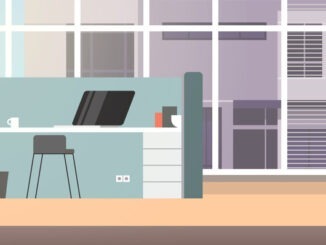
As open-plan offices evolve, the broken plan concept is emerging as a solution that balances collaboration with structured workspaces, offering a more dynamic and functional office environment
For businesses with larger working spaces, open plan office design has been a go-to for past few years. However things are changing, and a new trend is emerging that offers a balanced solution between open space and fully separated workstations. This approach is known as the broken plan concept and is one that dealers should know about.
Strategic Space Management
The broken plan office layout strategically divides the open space into designated sections without completely closing off areas, allowing for better space management. Unlike traditional zoning, which assigns areas for specific functions, broken plan design focuses on creating subtle separations using furniture and architectural elements to improve flow and functionality.
One of the major drawbacks of a fully open-plan office is that all employees share the same space, regardless of their job functions. This can lead to distractions, noise and decreased productivity. Broken plan design addresses this issue by incorporating structural and furniture-based solutions to create break points while preserving the lightness, airiness and collaborative aspects of an open environment.
Key Design Elements
To effectively create a broken plan office, businesses should consider a combination of carefully selected furniture and design elements that naturally divide the workspace without compromising accessibility and collaboration. Here are some key elements for dealers to consider when guiding customers:
Modular Shelving and Screen Panels
Freestanding shelving units, especially those without backs, serve as subtle dividers that define spaces without blocking light or making areas feel smaller. Modular shelving systems add further flexibility, allowing adjustments as needed to suit changing layouts or storage needs. Additionally, incorporating materials like lighter woods or glass in dividers enhances the aesthetic appeal while preserving openness. Acoustic screen panels made from fabric or perforated materials can also help reduce noise without completely closing off spaces, striking a balance between privacy and a connected environment.
Tiered and Multi-Level Seating
Tiered seating areas create organic meeting spaces while naturally defining different zones. Sofa circles or semi-enclosed lounge areas foster a relaxed and collaborative atmosphere, making them ideal for informal discussions. Additionally, ottomans and benches at varying heights provide flexible seating options, serving as impromptu discussion hubs that adapt to different group sizes and needs.
High and Low-Level Design Elements
Low-hanging pendant lights help define different zones while maintaining an open and cohesive feel, while multi-level lighting – such as floor lamps and recessed lighting -enhance both ambiance and functionality. Greenery placed at varying heights, including hanging plants and tall potted plants, introduce a natural flow and a sense of depth. Other high-low design elements can further enrich the space, such as a combination of low-profile furniture with tall decorative elements like vertical wall art.
Interactive Elements
Mobile whiteboards or corkboards act as creative dividers, providing both separation and a functional surface for brainstorming or organisation. Additional interactive elements can further enhance adaptability, such as writable glass panels for collaboration, sliding pegboards for customisable storage and display, or fold-out desks that integrate into partition walls to create instant workstations.
When designing a broken plan office, the key is to maintain the positive attributes of an open-plan space while introducing strategic break points to create a balanced, efficient work environment. By incorporating a mix of high and low elements, modular furniture and subtle dividers, businesses can enjoy the best of both worlds: an open yet structured office that fosters productivity and creativity. By carefully selecting furniture and design elements, dealers can help create workspaces that support both collaboration and concentration, ensuring a more productive and engaging office environment.


Be the first to comment